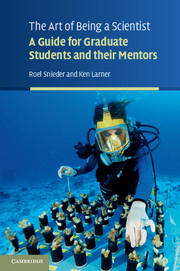Book contents
- Frontmatter
- Contents
- 1 Introduction
- 2 What is science?
- 3 Choices, choices, choices
- 4 The adviser and thesis committee
- 5 Questions drive research
- 6 Giving direction to our work
- 7 Turning challenges into opportunities
- 8 Ethics of research
- 9 Using the scientific literature
- 10 Communication
- 11 Publishing a paper
- 12 Time management
- 13 Writing proposals
- 14 The scientific career
- 15 Applying for a job
- 16 Concluding remarks
- Appendix A Further reading
- Appendix B A sample curriculum
- Appendix C The Refer and BibTeX format
- References
- About the authors
- Index
7 - Turning challenges into opportunities
Published online by Cambridge University Press: 05 June 2014
- Frontmatter
- Contents
- 1 Introduction
- 2 What is science?
- 3 Choices, choices, choices
- 4 The adviser and thesis committee
- 5 Questions drive research
- 6 Giving direction to our work
- 7 Turning challenges into opportunities
- 8 Ethics of research
- 9 Using the scientific literature
- 10 Communication
- 11 Publishing a paper
- 12 Time management
- 13 Writing proposals
- 14 The scientific career
- 15 Applying for a job
- 16 Concluding remarks
- Appendix A Further reading
- Appendix B A sample curriculum
- Appendix C The Refer and BibTeX format
- References
- About the authors
- Index
Summary
The brick walls are there for a reason. They're not there to keep us out. The brick wallls are there to give us a chance to show how badly we want something.
Pausch, 2008Seldom is the path toward success in research either straight or fully charted in advance. Stumbling blocks abound in any research. In this chapter we cover some of the common ones and offer suggestions for steps in conducting research aimed at minimizing their harm and even turning them to advantage.
BEING CONFUSED BECAUSE OF LACK OF DIRECTION
Research can be a confusing activity. Your research plan might be poorly formulated; worse, you might have no plan at all. At times you cannot understand intermediate results of your studies; data that you've recorded might conflict with a theory you developed, or two different lines of reasoning that both seem to make sense give different answers.
The first source of confusion, in which the work basically lacks direction, is clearly a negative one and needs to be fixed early on. Any of a variety of factors can have caused this state of stagnation. Perhaps you have not yet settled on a research topic or you have decided on one but the choice is insufficiently specific to get started on the research. You can avoid this pitfall by being aggressive in choosing and refining a research topic quickly. General considerations when choosing the research topic were given in Chapter 3.
- Type
- Chapter
- Information
- The Art of Being a ScientistA Guide for Graduate Students and their Mentors, pp. 93 - 109Publisher: Cambridge University PressPrint publication year: 2009



